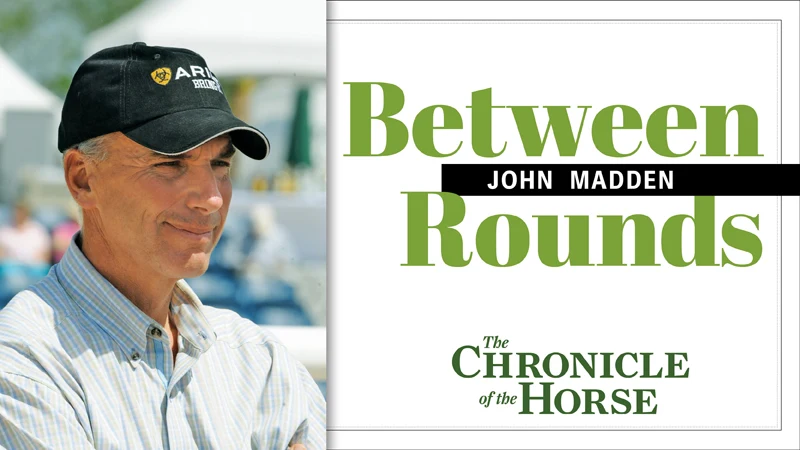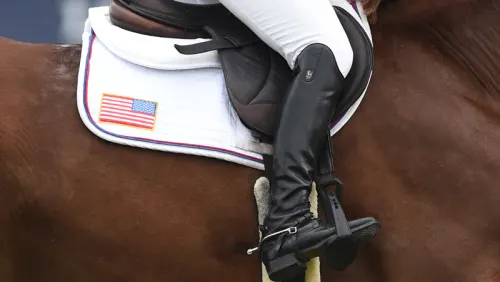Our columnist sees the Winter Equestrian Festival, in particular, as the future springboard to top international championships.
Wow! I just finished watching the first round of the Rolex FEI World Cup Show Jumping Finals on my computer on FEI TV, and the quality and convenience of the live stream was fantastic.
The Americans had a great day—Rich Fellers with Flexible won with McLain Ward and Sapphire right behind in second. Todd Minikus and Pavarotti were fifth, and Mario Deslauriers and Urico finished seventh. Notably, Hunter Harrison’s Let’s Fly, ridden by Rodrigo Pessoa, was third, and Luciana Diniz was fourth.
Eventually, the competition ended with a German victory and Sapphire’s controversial elimination. But the U.S. contingent had some impressive performances throughout the competition in Geneva, Switzerland, with Mario and Richard Spooner claiming top-10 spots.
It’s noteworthy that in the first round’s speed leg four of the top 10 were American, six out of the top 10 and five out of the top five were all regulars on the Florida circuit. This is a testament to the importance and improvements of the Winter Equestrian Festival in Wellington.
The Olympic Games, World Equestrian Games and World Cup Finals, in that order, are the pinnacle of our discipline. The strata just below would be top-level Nations Cups (previously the Super League) and the “majors” such as the Grand Prix of Aachen (Germany) and the CN International at Spruce Meadows (Alta.).
The next tier down, while highly valued and crucial to the working of our sport, may have the prize money but doesn’t have the tradition and cachet of these other international events. The third tier is really the business of our business; it’s what feeds the grassroots to the future Olympians and allows us to rise to the top-tier competitions.
Striking A Balance
WEF fits into this tier, as it’s a nursery of sorts for horse and rider. It’s spring training, and it’s also top-level competition in all divisions, including international sport.
ADVERTISEMENT
Let’s face it. We can’t have top-level international sport for 12 weeks straight in the same place. As evidence, I believe McLain competed Sapphire in five individual competitions out of the hundreds offered at WEF. Striking the balance of being an equestrian lifestyle and destination center, while offering the appropriate number of top international events is a significant challenge.
I’d like to commend all of the families and individuals of Wellington Equestrian Partners. They’ve made a commitment to the Wellington community and our sport, and they invested time and money, not without significant risk. Their company, Equestrian Sport Productions, has done many things to improve not only the Palm Beach International Equestrian Center venue, but also the organization of the shows. The production quality has improved dramatically, everything from video to the VIP tent to the parking and golf cart traffic routes have been improved.
Thoughtful people will realize the economic commitment of WEP and understand that Rome cannot be built in a day. At the same time, we can expect improvements as debt service decreases and as real estate sells.
It’s understandable at this point why costs to exhibitors are higher than ever. It’s understandable that we repeatedly jump our horses in the same venue over the same fences. It’s understandable why, for now, we jump our horses on what is the best all-weather high-volume footing and not the gold standard of turf. It’s understandable that we have small numbers of spectators for most events.
Three’s A Charm
While all of these situations are understandable, I’d like to offer my vision for the future.
It seems that we’ve reached a minimum critical mass of riders, owners, vendors and horse people. The community is growing and becoming large enough—with millions of dollars generated annually for Florida—that this group has the ability to attract sponsors, media and the attention of the general population.
Therefore, I see the need for two additional venues in Wellington, places each unique in character and purpose.
One venue could be designed as a fan-, sponsor- and TV-friendly facility with emphasis on showcasing elite events. This venue could include an indoor facility with more extensive corporate entertainment, emphasis on fan comfort and the ability to produce widely diverse events for the exhibitor. This venue would be designed for the international athlete and capable of highlighting the pinnacle of the sports, including hunters, equitation, juniors and amateurs. This venue could potentially occupy a rather small footprint.
ADVERTISEMENT
I see the next additional venue as one that would meet a fundamental need of the horse—space. This facility would have a much more country-type atmosphere that would focus on horse-friendly conditions, including grass fields and grass competition rings. This venue, of course, would be accessible to fans and corporate sponsors but would most likely need to be set up temporarily for special events.
This venue could be an expansion of the Old Polo Stadium and grass field currently being used at the corner of Pierson and South Shore roads in Wellington.
Top-level international sport would be featured once or twice at each venue during the WEF circuit. The winter circuit there should host a maximum of about four top international events, and the varying venues would satisfy that need. To pay for it all, real estate prices will skyrocket in the immediate vicinity of the venues. My hope is that these additional venues develop through growth and cooperation of all stakeholders.
Of course, there are still details to be improved upon, and I find myself worried about WEF’s focus on nightlife. While Saturday night jumping is a clear improvement for competitors and spectators, the rowdy atmosphere and excessive drinking aren’t taking us in a good direction. I’m not against nightlife, and I’m not against adults enjoying an adult beverage. I just hope that the challenge of segregating and keeping this element contained in the right place at the right times will be met.
We should cherish and foster the wholesome family-friendly environment of equestrian sports. That being said, I think WEF brought us a fantastic improvement in offering The Great Charity Challenge Pro-Am Event on March 20. This event featured family entertainment, music, team show jumping and raised money for 24 Palm Beach County charities. These sorts of initiatives, which showcase the good our sport can do in communities, are the ones to perpetuate.
It’s truly admirable what people can do when they get together and work toward a common goal.
John Madden, Cazenovia, N.Y., is married to international grand prix rider Beezie Madden. Together, they operate John Madden Sales Inc., where they train horses and riders. The horse business has encompassed John’s entire life, and in addition to his business he’s the Organizing Committee Chairman for the Syracuse Sporthorse Tournament (N.Y.) and on the USEF High Performance Show Jumping Computer List Task Force. He began contributing to Between Rounds in 2008.















